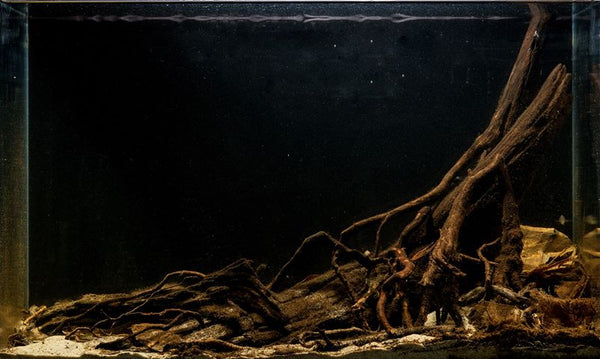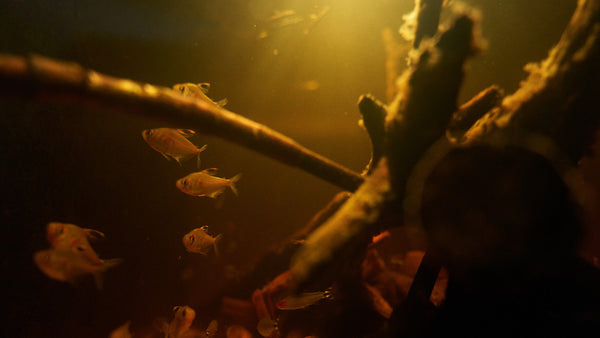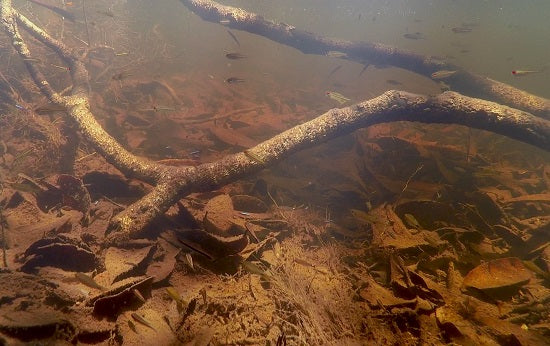- Continue Shopping
- Your Cart is Empty
It's not "dirty"- it's perfect.
We receive a lot of questions about the maintenance of botanical-method aquariums. And it makes a lot of sense, because the very nature of these aquariums is that they are stocked, chock-full of seed pods and leaves, all of which contribute to the bio load of the aquarium- all of which are in the process of breaking down and decomposing to some degree at any given moment.
It's not so much if you have to pay attention to maintenance with these tanks- it's more of a function of how you maintain them, and how often. Well, here's the "big reveal" on this:
Keep the environment stable.

Environmental stability is one of the most important- if not THE most important- things we can provide for our fishes! To me, it's more about doing something consistently than it is about some unusual practice done once in a while.
Like, ya' know- water exchanges.
Obviously, water exchanges are an important part of any aquarium husbandry regimen, and I favor a 10% weekly exchange. Iit's the regimen I've stuck with for decades, and it's never done me wrong. I think that with a botanical influenced aquarium, you've got a lot of biological material in there in addition to the fishes (you know, like decomposing leaves and softening seed puds- stuff like that), and even in well-managed, biologically-balanced aquarium, you still want to minimize the effects of any organics accumulating in a detrimental manner.
This piece is not really about water changes, and frankly, you can utilize whatever schedule/precentage works for you. The 10% weekly has worked for me; you may have some other schedule/percentage. My advice: Just do what works and adjust as needed.
Enough said.
Of course, the other question I receive all the time about botanical method aquairums is, "Do you let the leaves decompose completely in your tank, or do you remove them?"
I have always allowed leaves and botanicals to remain in my system until they completely decompose.
This is generally not a water-quality-affecting issue, in my experience, and the decision to remove them is more a matter of aesthetic preferences than function. There are likely times when you'll enjoy seeing the leaves decompose down to nothing, and there are other times when you might like a "fresher" look and replace them with new ones relatively soon.
It's your call.

However, I believe that the benefits of allowing leaves and botanicals to remain in your aquariums until they fully decompose outweigh any aesthetic reservations you might have. A truly natural functioning-and looking- botanical method aquarium has leaves decomposing at all times. There are, in my opinion, no downsides to keeping your botanical materials "in play" indefinitely.
I have never had any negative side effects that we could attribute to leaving botanicals to completely break down in an otherwise healthy, well-managed aquarium.
And from a water chemistry perspective?
Many, many hobbyists (present company included) see no detectable increases in nitrate or phosphate as a result of this practice.
Of course, this has prompted me to postulate that perhaps they form a sort of natural "biological filtration media" and actually foster some dentritifcation, etc. I have no scientific evidence to back up this theory, of course (like most of my theories, lol), other than my results, but I think there might be a grain of truth here!

Remember: A truly "Natural" aquarium is not sterile. It encourages the accumulation of organic materials and other nutrients- not in excess, of course.
The love of pristine, sterile-looking tanks is one of the biggest obstacles we need to overcome to really advance in the aquarium hobby, IMHO. Stare at a healthy, natural aquatic habitat for a bit and tell me that it's always "pristine-looking..."

Lose the "clean is the ultimate aesthetic" mindset. Please.
"Aesthetics first" has created this weird dichotomy in the hobby.
Like, people on social media will ooh and awe when pics of beautiful wild aquatic habitats- many of which absolutely looked nothing like what we do in aquariums- are shared. They'll comment on how amazing Nature is, and admire the leaf litter and tinted water and stuff.

Yet, when it comes time to create an aquarium, they'll almost always "opt out" of attempting to create such a tank in their own home, and instead create a surgically-sterile aquatic art piece instead.
Like, WTF?
Why is this?
I think it's because we've been convinced by...well, almost everybody in the hobby- that it's not advisable or practical- or even possible- to create a truly functional natural aquarium system. It's easier to look for the sexiest named rock and designer wood and mimic some "award winning" 'scape instead.
Ouch.
I think that many hobbyists have lost sight of the fact that there are enormous populations of organisms which reside in their aquariums which process, utilize, and assimilate the waste materials that everyone is so concerned about. We eschew natural methods in place of technology, because it's in our minds that "natural methods" = "aesthetically challenged."
So we go for expensive filters...We've become convinced that technology is our salvation.
The reality is that a convergence of simple technology and embracing of fundamental ecology is what make successful aquariums- well-successful. In many cases (notice the caveat "many"...) you don't need a huge-capacity, ultra-powerful high-priced filter to keep your tank healthy. You don't need massive water exchanges and ultra meticulous water exchange/siphoning sessions to sustain your aquarium for indefinite periods of time.
What you need is a combination of a decent filter system, a regular schedule of small simple water exchanges, and a healthy and unmolested microbiome of beneficial organisms within your aquarium.

Let Nature do Her thing.
Biofilms, fungi, algae...detritus...all have their place in the aquarium. Not as an excuse for lousy or lazy husbandry- but as supplemental food sources which also happen to "power" the ecology in our tanks.

Let's just focus on our BFFs, the fungi, for a few more minutes. We've given them love for years here...long before hashtags like "#fungal Friday "or whatever became a "thing" on The 'Gram.
And of course, as we've discussed many times here, fungi are actually an important food item for other life forms in the aquatic environments tha we love so much! In one study I stumbled across, gut content of over 100 different aquatic insects collected from submerged wood and leaves showed that fungi comprised part of the diet of more than 60% of them, and, in turn, aquatic fungi were found in gut content analysis of many species of fishes!

One consideration: Bacteria and fungi that decompose decaying plant material in turn consume dissolved oxygen for respiration during the process.
This is one reason why we have warned you for years that adding a huge amount of botanical material at one time to an established, stable aquarium is a recipe for disaster. There is simply not enough fungal growth or bacteria to handle it. They reproduce extremely rapidly, consuming significant oxygen in the process.
Bad news for the impatient.
So just be patient. Learn. Embrace this stuff.
Support. Co-dependency. Symbiosis. Whatever you want to call it- the presence of fungi in aquatic ecosystems is extremely important to other organisms.
You can call it free biological filtration for your aquarium!
In the botanical-method aquarium, ecology is 9/10's of the game. Think about this simple fact:
The botanical materials present in our systems provide enormous surface area upon which beneficial bacterial biofilms and fungal growths can colonize. These life forms utilize the organic compounds present in the water as a nutritional source.
GREAT news for the patient, the studious, and the accepting.
Think about this: These life forms arrive on the scene in Nature, and in our tanks, to colonize appropriate materials, to process organics in situ on the things that they're residing upon (leaves, twigs, branches, seed pods, wood, etc.).

So removing it is, at best, counterproductive.
Yeah, if you intervene by removing stuff, bad things can happen. Like, worse things than just a bunch of gooey-looking fungal and biofilm threads on your wood. Your aquarium suddenly loses its capability of processing the leaves and associated organics, and- who's there to take over?
Okay, I'm repeating myself here- but there is so much unfounded fear and loathing over aquatic fungi that someone has to defend their merits, right? Might as well be me!
My advice; my plea to you regarding fungal growth in your aquarium? Just leave it alone. It will eventually peak, and ultimately diminish over time as the materials/nutrients which it uses for growth become used up. It's not an endless "outbreak" of unsightly (to some) fungal growth all over your botanicals and leaves.
It goes away significantly over time, but it's always gonna be there in a botanical method aquarium.

"Over time", by the way is "Fellman Speak" for "Please be more fucking patient!"
Seriously, though, hobbyists tend to overly freak out about this kind of stuff. Of course, as new materials are added, they will be colonized by fungi, as Nature deems appropriate, to "work" them. It keeps going on and on...
It's one of those realities of the botanical-method aquarium that we humans need to wrap our heads around. We need to understand, lose our fears, and think about the many positives these organisms provide for our tanks. These small, seemingly "annoying" life forms are actually the most beautiful, elegant, beneficial friends that we can have in the aquarium. When they arrive on the scene in our tanks, we should celebrate their appearance.
Why?
Because their appearance is yet another example of the wonders of Nature playing out in our aquariums, without us having to do anything of consequence to facilitate their presence, other than setting up a tank embracing the botanical method in the first place. We get to watch the processes of colonization and decomposition occur in the comfort of our own home. The SAME stuff you'll see in any wild aquatic habitat worldwide.

Amazing.
And the end result of the work of fungal growths, bacteria, and grazing organisms?
Detritus.
"Detritus is dead particulate organic matter. It typically includes the bodies or fragments of dead organisms, as well as fecal material. Detritus is typically colonized by communities of microorganisms which act to decompose or remineralize the material." (Source: The Aquarium Wiki)
Well, shit- that sounds bad!
It's one of our most commonly used aquarium terms...and one which, well, quite frankly, sends shivers down the spine of many aquarium hobbyists. And judging from that definition, it sounds like something you absolutely want to avoid having in your system at all costs. I mean, "dead organisms" and "fecal material" is not everyone's idea of a good time, ya know?
Literally, shit in your tank, accumulating. Like, why would anyone want this to linger- or worse- accumulate- in your aquarium?
Yet, when you really think about it and brush off the initial "shock value", the fact is that detritus is an important part of the aquatic ecosystem, providing "fuel" for microorganisms and fungi at the base of the food chain in aquatic environments. In fact, in natural aquatic ecosystems, the food inputs into the water are channeled by decomposers, like fungi, which act upon leaves and other organic materials in the water to break them down.

And the leaf litter "community" of fishes, insects, fungi, and microorganisms is really important to these systems, as it assimilates terrestrial material into the blackwater aquatic system, and acts to reduce the loss of nutrients to the forest which would inevitably occur if all the material which fell into the streams was simply washed downstream!

That sounds all well and good; even grandiose, but what are the implications of these processes- and the resultant detritus- for the closed aquarium system?
Is there ever a situation, a place, or a circumstance where leaving the detritus "in play" is actually a benefit, as opposed to a problem?
I think so. Like, almost always.

In years past, aquarists who favored "sterile-looking" aquaria would have been horrified to see this stuff accumulating on the bottom, or among the hardscape. Upon discovering it in our tanks, it would have taken nanoseconds to lunge for the siphon hose to get this stuff out ASAP!
In our world, the reality is that we embrace this stuff for what it is: A rich, diverse, and beneficial part of our microcosm. It provides foraging, "Aquatic plant "mulch", supplemental food production, a place for fry to shelter, and is a vital, fascinating part of the natural environment.

It is certainly a new way of thinking when we espouse not only accepting the presence of this stuff in our aquaria, but actually encouraging it and rejoicing in its presence!
Why?
Well, it's not because we are thinking, "Hey, this is an excuse for maintaining a dirty-looking aquarium!"
No.
We rejoice because our little closed microcosms are mimicking exactly what happens in the natural environments that we strive so hard to replicate. Granted, in a closed system, you must pay greater attention to water quality, but accepting decomposing leaves and botanicals as a dynamic part of a living closed system is embracing the very processes that we have tried to nurture for many years.

And it all starts with the 'fuel" for this process- leaves and botanicals. As they break down, they help enrich the aquatic habitat in which they reside. Now, in my opinion, it's important to add new leaves as the old ones decompose, especially if you like a certain "tint" to your water and want to keep it consistent.
However, there's a more important reason to continuously add new botanical materials to the aquarium as older ones break down:
The aquarium-or, more specifically- the botanical materials which comprise the botanical-method aquarium "infrastructure" acts as a biological "filter system."
In other words, the botanical materials present in our systems provide enormous surface area upon which beneficial bacterial biofilms and fungal growths can colonize. These life forms utilize the organic compounds present in the water as a nutritional source.

Think about that concept for a second.
It's changed everything about how I look at aquarium management and the creation of functional closed aquatic ecosystems.
It's really put the word "natural" back into the aquarium keeping parlance for me. The idea of creating a multi-tiered ecosystem, which provides a lot of the requirements needed to operate successfully with just a few basic maintenance practices, the passage of time, a lot of patience, and careful observation.
It takes a significant mental shift to look at some of this stuff as aesthetically desirable; I get it. However, for those of you who make that mental shift- it's a quantum leap forward in your aquarium experience.

It means adopting a different outlook, accepting a different, yet very beautiful aesthetic. It's about listening to Nature instead of the asshole on Instagram with the flashy, gadget-driven tank. It's not always fun at first for some, and it initially seems like you're somehow doing things wrong.
It's about faith. Faith in Mother Nature, who's been doing this stuff for eons. Mental "unlocks" are everywhere...the products of our experience, acquired skills, and grand experiments. Stuff that, although initially seemingly trivial, serves to "move the needle" on aquarium practice and shift minds over time.
A successful botanical method aquarium need not be a complicated, technical endeavor; rather, it should rely on a balanced combination of knowledge, skill, technology, and good judgement. Oh- and a bunch of "mental shifts!"
Take away any one of those pieces, and the whole thing teeters on failure.
Utilize all of these things to your advantage and enjoy your hobby more than ever!

Remember, your botanical method aquarium isn't "dirty."
It's perfect.
Just like Nature intended it to be.
Stay bold. Stay grateful. Stay thoughtful. Stay curious. Stay diligent...
And Stay Wet.
Scott Fellman
Tannin Aquatics








Scott Fellman
Author